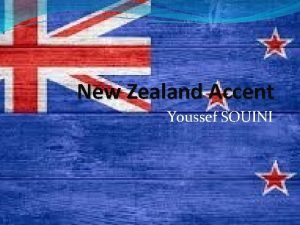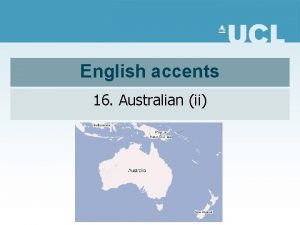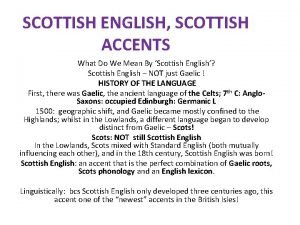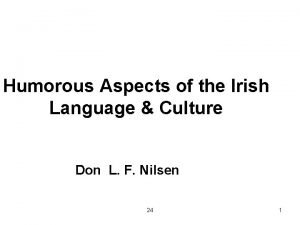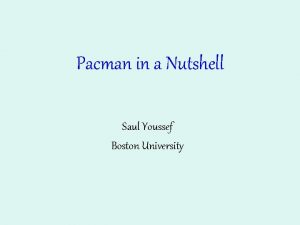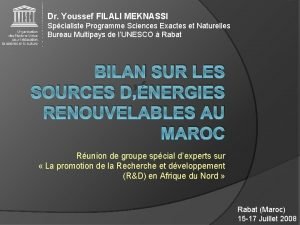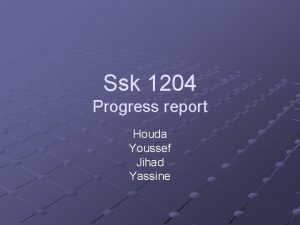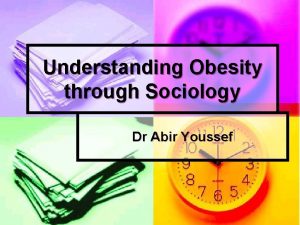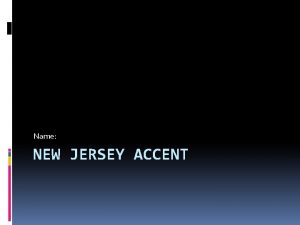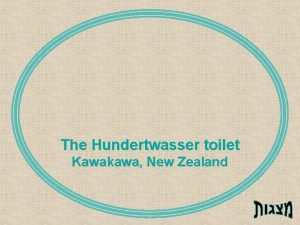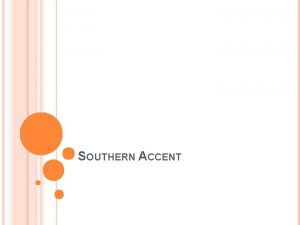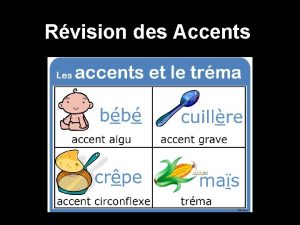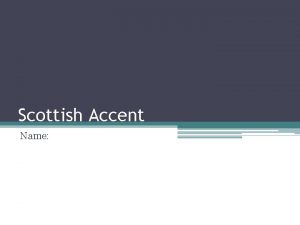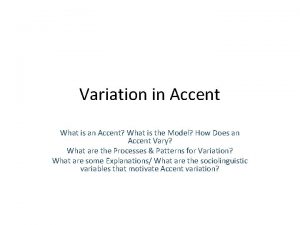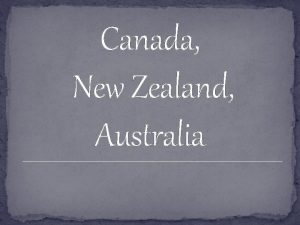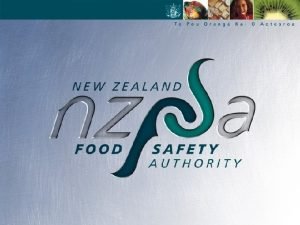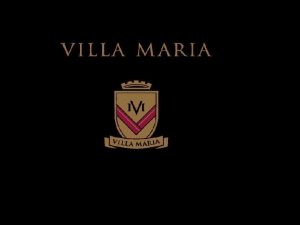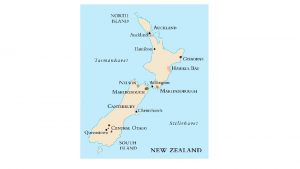New Zealand Accent Youssef SOUINI New Zealand English
















- Slides: 16

New Zealand Accent Youssef SOUINI

New Zealand English �The English language was established in New Zealand by colonists during the 19 th century. It is one of "the newest native-speaker varieties of the English language in existence, a variety which has developed and become distinctive only in the last 150 years". The most distinctive influences on New Zealand English have come from Australian English, English in southern England, Irish English, Scottish English, the prestige Received Pronunciation, and Māori

Māori English �One form of New Zealand English increasingly heard is Māori English. Distinctive features of Māori English are the High Rising Terminal, where the tone is high at the end of a statement, the use of 'eh' at the end of a sentence and front pronunciation of the GOOSE vowel �Speakers of Māori English commonly end questioning sentences with 'eh' (pronounced to rhyme with 'may')

�The everyday use of Maori words, usually colloquial, occurs most prominently among youth, young adults and Maori populations. Examples include words like kia ora ("hello"), orkai ("food") which almost all New Zealanders know. �Māori is ever present and has a significant conceptual influence in the legislature, government, and community agencies (e. g. health and education), where legislation requires that proceedings and documents be translated into Māori (under certain circumstances, and when requested). Political discussion and analysis of issues of sovereignty, environmental management, health, and social well-being thus rely on Māori at least in part. Māori as a spoken language is particularly important wherever community consultation occurs.

Features of Māori English �The High Rising Terminal intonation pattern is used in Pākehā English but appears more frequently in Māori English. �The use of ‘eh’ at the end of a sentence is more common in Māori English than Pākehā English. �GOOSE has a very front pronunciation (like the French ‘tu’).

Features of the New Zealand accent �Phonemes: �Phonologically New Zealand English (NZE) has the same 20 -vowel phoneme system as British Received Pronunciation (RP), but the New Zealand phonemes are realised differently from RP. However, many New Zealand speakers in the 2000 s have only 19 vowel phonemes because they do not make a distinction between the phonemes in NEAR and SQUARE.

Vowels in the New Zealand accent �START vowel: �In NZE the START vowel in words like ‘park’, ‘calm’ and ‘farm’ is central or even front of central in terms of tongue position. It is one of the most noticeable features of New Zealand Australian English for people in the northern hemisphere. Unlike today, almost half of a sample of people born in the later 19 th century and interviewed in the 1940 s used the short vowel of TRAP in words like ‘dance’ and ‘chance’. This is a feature of Australian English in the early 2000 s.

�KIT vowel: �The pronunciation of the KIT vowel clearly distinguishes New Zealanders from Australians. It is commonly claimed that New Zealanders say ‘fush and chups’ where Australians say ‘feesh and cheeps’. �GOOSE and FLEECE vowels: �In NZE the GOOSE vowel is very central. It is sometimes realised as a diphthong (a speech sound which begins in the position of one vowel and glides to another) so that ‘boot’ sounds like ‘boat’. The FLEECE vowel can also appear as a diphthong so that‘feet’ sounds like ‘fuh-eet’


�TRAP and DRESS vowels �The TRAP vowel is raised (pronounced with a high tongue position) in NZE, and outside New Zealand is often mistaken for the DRESS vowel. A New Zealander overseas, Pat, asked people to address him as Patrick instead because he disliked being asked why he was called ‘pet’. The DRESS vowel is also raised in NZE and can be confused with KIT – which is why New Zealanders overseas are given pins when they ask for pens. �A recent change is the further raising of the DRESS vowel into the area of the FLEECE vowel, so that ‘best’ can sound like ‘beast’, and ‘bed’ like ‘bead’.

�NURSE vowel �In NZE this is pronounced with rounded lips, and is relatively front and high so it overlaps with the GOOSE vowel. This can cause confusion, where outsiders might hear the NZE word ‘terms’ as ‘tombs’.

High Rising Terminal Contour �The most widely reported intonational feature of NZE is the High Rising Terminal Contour (HRT), a rise in pitch used on declarative sentences. Outsiders mistakenly interpret this as a questioning intonation pattern. The HRT is a politeness feature used by a speaker wishing to involve the hearer in a conversation.

Sound changes in speech �/l/ �A widespread New Zealand English (NZE) sound change involves /l/ after vowels, whereby tongue-tip contact is lost and /l/ is vocalised (becomes a vowel like that in FOOT). ‘Feel’ becomes ‘fee-u’, railway becomes ‘rai-u-way’. This change is occurring in other varieties of English but it seems to be more advanced in NZE.

�Vowels preceding l �Changes in the vowels preceding /l/ were noted by Arnold Wall in 1939. He complained that ‘result’ had become ‘resolt’ and ‘children’ sounded like ‘chuldren. ’ For many NZE speakers there is little or no difference between ‘doll’, ‘dole’ and ‘dull’. Complaints appear regularly about ‘wallington’ for ‘Wellington’, or ‘the elps’ for ‘the alps’. People named ‘Ellen’ and ‘Alan’ can have their names confused.

References �Gordon, Elizabeth, and others. New Zealand English: its origins and evolution. Cambridge: Cambridge University Press, 2004. �Hay, Jennifer, Margaret Maclagan and Elizabeth Gordon. New Zealand English. Edinburgh: Edinburgh University Press, 2008. �http: //www. teara. govt. nz/en �http: //en. wikipedia. org/wiki/New_Zealand_English �https: //www. youtube. com/watch? v=Wz 29_b. Fx. BZA&s pfreload=10

 Difference between australian and new zealand accent
Difference between australian and new zealand accent New zealand vs australian accent
New zealand vs australian accent New zealand national sport
New zealand national sport New zealand official languages english
New zealand official languages english English scottish accent
English scottish accent Aitchison labelling packaging network building
Aitchison labelling packaging network building Hiberno-english
Hiberno-english Saul youssef
Saul youssef Youssef el sebai
Youssef el sebai Youssef atigui
Youssef atigui Youssef hashash
Youssef hashash Frida youssef
Frida youssef Youssef filali
Youssef filali Houda youssef
Houda youssef Abir youssef
Abir youssef New jersey accent
New jersey accent Kawakawa toilets
Kawakawa toilets
